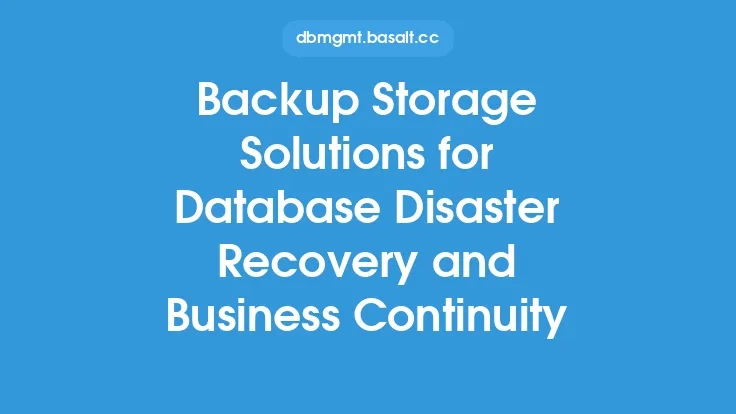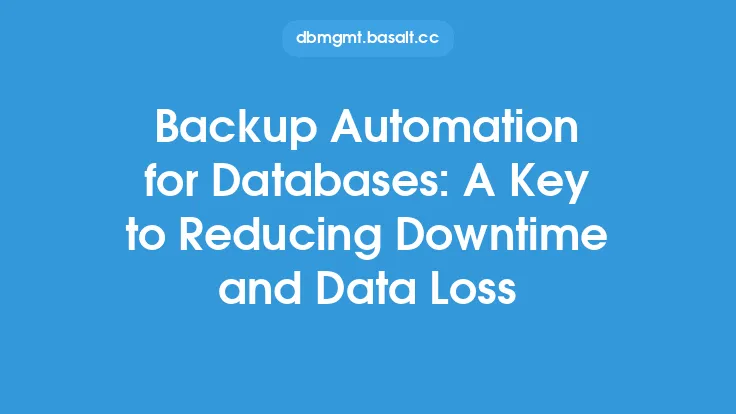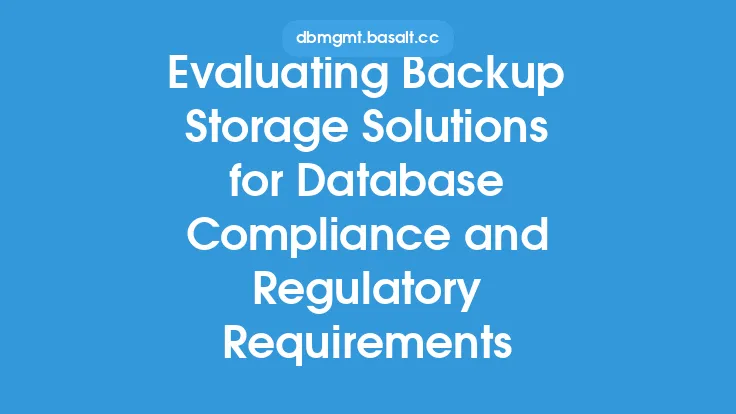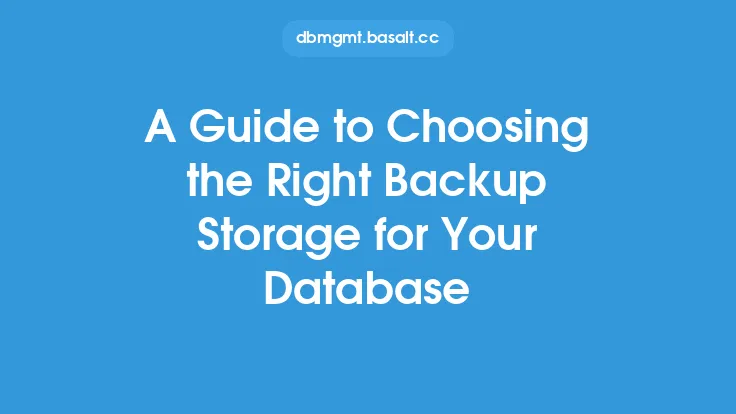When it comes to database backup storage solutions, there are several options available, each with its own set of advantages and disadvantages. The choice of backup storage solution depends on various factors such as the size and complexity of the database, the required level of data protection, and the available budget. In this article, we will delve into the different types of backup storage solutions for databases, exploring their pros and cons, and discussing the key considerations for selecting the most suitable option.
Types of Backup Storage Solutions
There are several types of backup storage solutions available for databases, including tape backup, disk-based backup, cloud-based backup, and hybrid backup. Each of these solutions has its own strengths and weaknesses, which are discussed below.
Tape backup is a traditional method of backing up databases, which involves storing data on magnetic tapes. The pros of tape backup include its low cost, high capacity, and long-term data retention. However, the cons include its slow data transfer rates, limited accessibility, and high maintenance requirements. Tape backup is suitable for large databases with low data change rates, but it may not be the best option for databases with high transaction rates or strict recovery time objectives.
Disk-based backup, on the other hand, involves storing data on hard disk drives or solid-state drives. The pros of disk-based backup include its fast data transfer rates, high accessibility, and low maintenance requirements. However, the cons include its high cost, limited capacity, and short-term data retention. Disk-based backup is suitable for small to medium-sized databases with high transaction rates or strict recovery time objectives.
Cloud-based backup involves storing data in a cloud-based storage service, such as Amazon S3 or Microsoft Azure Blob Storage. The pros of cloud-based backup include its scalability, flexibility, and cost-effectiveness. However, the cons include its dependence on internet connectivity, potential security risks, and limited control over data storage. Cloud-based backup is suitable for databases with variable data growth rates or limited on-premise storage capacity.
Hybrid backup combines the benefits of tape backup, disk-based backup, and cloud-based backup. The pros of hybrid backup include its flexibility, scalability, and cost-effectiveness. However, the cons include its complexity, high maintenance requirements, and potential compatibility issues. Hybrid backup is suitable for large databases with variable data growth rates or strict recovery time objectives.
Key Considerations for Selecting a Backup Storage Solution
When selecting a backup storage solution for a database, there are several key considerations to keep in mind. These include the required level of data protection, the available budget, the size and complexity of the database, and the required recovery time objective.
The required level of data protection is a critical consideration, as it determines the frequency and granularity of backups. For example, a database with high transaction rates may require more frequent backups to ensure data consistency and integrity.
The available budget is another important consideration, as it determines the cost-effectiveness of the backup storage solution. For example, a small to medium-sized database may not require a high-end backup storage solution, while a large database may require a more robust and scalable solution.
The size and complexity of the database are also important considerations, as they determine the required capacity and performance of the backup storage solution. For example, a large database with high data growth rates may require a scalable backup storage solution with high capacity and fast data transfer rates.
The required recovery time objective is a critical consideration, as it determines the required speed and efficiency of the backup storage solution. For example, a database with strict recovery time objectives may require a fast and efficient backup storage solution with low recovery times.
Technical Considerations for Backup Storage Solutions
When evaluating backup storage solutions for databases, there are several technical considerations to keep in mind. These include the backup protocol, data compression, data encryption, and data deduplication.
The backup protocol is a critical consideration, as it determines the efficiency and effectiveness of the backup process. For example, a database with high transaction rates may require a backup protocol with low overhead and high throughput.
Data compression is another important consideration, as it determines the storage capacity and data transfer rates of the backup storage solution. For example, a database with high data growth rates may require a backup storage solution with high compression ratios to reduce storage costs.
Data encryption is a critical consideration, as it determines the security and integrity of the backup data. For example, a database with sensitive data may require a backup storage solution with robust encryption and access controls.
Data deduplication is another important consideration, as it determines the storage capacity and data transfer rates of the backup storage solution. For example, a database with high data redundancy may require a backup storage solution with high deduplication ratios to reduce storage costs.
Best Practices for Implementing Backup Storage Solutions
When implementing backup storage solutions for databases, there are several best practices to keep in mind. These include regular backup testing, backup data validation, and backup storage monitoring.
Regular backup testing is a critical best practice, as it ensures the integrity and recoverability of the backup data. For example, a database with high transaction rates may require regular backup testing to ensure data consistency and integrity.
Backup data validation is another important best practice, as it ensures the accuracy and completeness of the backup data. For example, a database with sensitive data may require backup data validation to ensure data integrity and security.
Backup storage monitoring is a critical best practice, as it ensures the availability and performance of the backup storage solution. For example, a database with high data growth rates may require backup storage monitoring to ensure storage capacity and data transfer rates.
Conclusion
In conclusion, selecting the right backup storage solution for a database is a critical decision that requires careful consideration of several factors, including the required level of data protection, the available budget, the size and complexity of the database, and the required recovery time objective. By understanding the pros and cons of different types of backup storage solutions, including tape backup, disk-based backup, cloud-based backup, and hybrid backup, database administrators can make informed decisions about the best backup storage solution for their database. Additionally, by following best practices for implementing backup storage solutions, database administrators can ensure the integrity, availability, and recoverability of their database.





